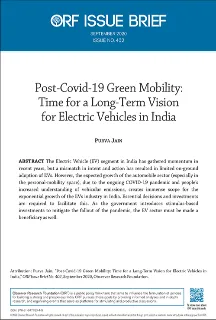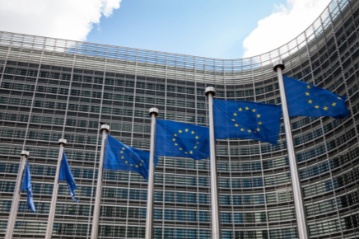Introduction
India’s Electric Vehicle (EV) segment has grown in recent years. The pace of such growth, however, has been slow; policy support has been insufficient for realising the full potential of the EV market. The sale of EVs remains low, especially when compared to Internal Combustion Engine (ICE) vehicles.
According to recent industry data,[1] in the first eight months of FY20 (April 2019 to November 2019), EV sales were a mere 0.7 percent of total passenger vehicle (PV) sales in the country. This is much lower than the global average of 2.7 percent (share of EV sales in total PV sales), which, too, is on the lower side, due to the slow growth in emerging economies.[2] In FY20, the total passenger EV sales (including two-wheelers) were 0.15 million in India in comparison to an annual sale of 2.1 million globally in 2019.[3] The onset of the COVID-19 pandemic has necessitated a policy shift, or even an overhaul, in various sectors of the economy. Within this shift, the Indian government must also rework its policy approach for the EV sector.
EV policy ecosystem in India
The uptake of EVs in India is expected to yield manifold benefits for the country, such as lowering pollution levels, enhancing energy security with improved balance-of-trade levels, and meeting global climate-change commitments. The increased use of EVs could reduce CO2 emissions by 37 percent.[4] It could also help curtail India’s dependence on oil imports and lower its massive import bills. India’s dependence on oil imports is steep, at around 85 percent (as of FY19) while the last import bill (FY20) was at a staggering US$102 billion despite a crash in crude-oil prices in the latter half of FY20.[5] Enhanced EV implementation will also enable India to fulfil the global commitments it has made to lower carbon emissions and increase cleaner sources of energy and transportation, including the Nationally Determined Contributions (NDCs) under the United Nations Framework Convention on Climate Change[a] and EV30@30.[b]
To facilitate the higher and faster rate of adoption of EVs in the country, a clear policy directive is essential. Indeed, some key policy decisions to this effect have been taken in recent years, e.g. the National Electric Mobility Mission Plan (NEMPP) 2020, launched in 2013 by the Department of Heavy Industry (DHI) as a roadmap for the faster manufacture and adoption of EVs in the country.[6] Under this plan, the Government of India aims to reach sales of six to seven million hybrid vehicles and EVs by 2020. Table 1 shows the EV sales in the country since the initiation of the scheme. The total sales up to March 2020 are approximately 400,000. This does not include three-wheeler EVs (e-rickshaws), dominated by unorganised sector sales, estimated to be at 1.5 million andcatering to a population of almost 60 million users daily.[7] India’s e-mobility segment is being driven by e-rickshaws at present, providing an affordable, cleaner and more efficient last-mile commute. With the comparatively lower upfront cost and the low average per-passenger and per-kilometre energy consumption, electric three-wheelers are considered one of the best ways for enhancing e-mobility in India. Companies such as Amazon are also considering electrifying their freight fleet.[8]
Table 1: EV Sales in India (2014–15 to 2019–20)
| Segment |
FY15 |
FY16 |
FY17 |
FY18 |
FY19 |
FY20 |
| e-2-wheelers |
|
20,000 |
23,000 |
54,800 |
126,000 |
152,000 |
| e-4-wheelers |
|
2,000 |
2,000 |
1,200 |
3,600 |
3,400 |
| Buses |
|
|
|
|
|
600 |
| Total |
16,000 |
22,000 |
25,000 |
56,000 |
129,600 |
156,000 |
Sources: CarandBike,[9] Inc42 Media,[10] AutocarPro,[11] Bloomberg Quint[12]
As part of the NEMMP 2020, the Faster Adoption and Manufacturing of (Hybrid &) Electric Vehicles in India (FAME India) Scheme was notified in April 2015, to promote the manufacture of electric and hybrid vehicle technology. Initially launched for a period of two years, FAME-I, the first phase of the scheme, was extended to a period of four years, until 31 March 2019. The focus areas of this phase included demand creation, technology platform, pilot project and charging infrastructure. A total of INR 5.29 billion was earmarked and utilised under the scheme, a major portion of which was demarcated for demand incentive (approximately INR 3.43 billion).[13] To encourage wider adoption, buyers were given demand incentive in the form of an upfront reduced purchase price.
Phase-II of the FAME Scheme was rolled out on 1 April 2019, to be implemented for a period of three years, until 31 March 2022. FAME-II received a massive outlay of INR 100 billion, compared to the meagre funding of FAME-I, of which only 60 percent was utilised. Thus, the outlay for FAME-II is almost 19 times more than the fund utilisation of FAME-I. This is a significant budget jump for a continued policy and can be attributed to the fact that the government views FAME-I as a way to set up the stage for enhanced EV mobility; FAME-II will then aim to increase EV adoption in the country. The budget allocation also indicates the government’s commitment to the EV sector, which in turn can motivate companies, researchers and buyers to allocate resources for the sector.
However, it is equally possible that the increase in budget is entirely arbitrary, as the projected financial outlay lacks clarity on both expected results and how best to allocate the funds. The initial notification of the scheme was not without hiccups, as it received mixed responses from industry experts. The incentives under FAME are applicable for EVs fitted with advanced chemistry battery and those used as commercial vehicles for public transportation. Further, there are maximum price and minimum top-speed requirements, amongst several conditions that must be met to avail incentives. Some of these conditions for FAME-II are different from those for the first phase. Some experts claim that those of FAME-II are so stringent that over 90 percent of electric two-wheelers are likely to lose the subsidy.[14] This directly impacts EV sales, which are further dampened because electric two-wheelers with an advanced lithium-ion battery are double in price, compared to those with the more popular lead-acid battery, which is excluded from FAME-II.
EV sales in India are mostly driven by electric two-wheelers and three-wheelers, and the four-wheeler segment is still small. The pace of this segment will continue to be slow, since there are limited incentives for the adoption of EVs in personal mobility, and none for four-wheelers. This is considered a shortcoming of FAME-II, since it leaves out incentivising a complete segment of mobility, which may impact the long-term adoptability of EVs in India. While it is a well-intentioned scheme, FAME-II may fail to deliver due to the sudden introduction of the stringent conditions. These should have been implemented in a phased manner and included sunset clauses for the benefit of the manufacturers, investors and consumers.
Moreover, if FAME-II delivers on the desired outcomes despite these conditions, supported by state-level policies, it will still be insufficient for the EV sector. To address this, a more consistent policy approach is required, which is holistic and will result in an enabling ecosystem for the sector. Currently, government support comes mostly in the form of “demand incentives,” with minimal efforts towards improving the infrastructure. Since the sector is still in a nascent stage in India, policy support is required to encourage EVs through an ecosystem of research, manufacturing, storage and charging infrastructure, along with disincentivising use of conventional fuel vehicles. As India moves from relief to recovery response for COVID-19, the government has the opportunity to take stock of the post-pandemic changes in buyer preferences and economic stimulus needs to help accelerate the EV sector in a holistic manner.
The way forward
The path to post-COVID-19 recovery is not clear and is going to be a difficult one. The government is taking measures to save lives and provide immediate relief but will have to engage in many longer-term revival measures as well. Such post-pandemic measures will establish the direction of various economic sectors for the future. The EV sector has only just started to move towards its potential in India, and in light of the COVID-19 outbreak, the government’s response could go either way: the pandemic could either force the government to strike it off the priority list or take the slowdown as an opportunity to promote the sector. Since stimulus must be provided to revive the economy, clean energy such as EV should be the government’s priority. For the EV sector, the government should work towards developing an ecosystem across the value chain. Now more than ever, policy actions with a long-term vision have become critical.
The government can potentially focus on the EV sector as part of its recovery stimulus to veer the economy back to pre-COVID-19 levels. The sector has massive growth potential and is being increasingly recognised as a viable alternative for cleaner mobility. So far, the key reasons for the slow uptake of EVs have been the concerns of reliability and affordability due to the higher upfront pricing, range anxiety, and lack of charging stations. To make EVs more affordable, manufacturing must be increased. This can lead to economies of scale, with equal effort being made to increase the demand by lowering upfront pricing through incentives and subsidies. Reliability issues can be solved by having a clearly chalked-out charging infrastructure plan. Currently, the EV sector is trapped in a cycle—manufacturing and charging stations remain limited due to a lack of demand, and the demand is poor because of a lack of economies of scale, keeping prices up and limiting the availability of charging stations. With a stimulus package, the government can provide a solution by promoting an ecosystem of manufacturing, demand, ancillary infrastructure, R&D and other relevant factors.
A key area where government stimulus can be critical for the EV sector is innovation. Adequate support must be provided for innovation in manufacturing, conversion kits, and end-of-life vehicle management for EVs. This requires both fiscal and non-fiscal incentives and a strong focus on innovative startups. The sector is still heavily dependent on imports, especially for batteries, which make up almost 50 percent of the cost of an EV. To create an EV-intensive future, it is critical to combat this import dependence, but it needs to be done in a phased manner. Imports have naturally been affected during the pandemic; it provides a window of opportunity to make a policy shift. To push for increased manufacturing in India, along with the ongoing efforts for battery manufacturing, such as through the National Mission on Transformative Mobility and Storage, the government must invest in battery-recycling or end-of-life (EOL) management and EV retrofitting.
The pandemic has created a fear of using public transport, and an increase in personal mobility is expected. In this scenario, it will be beneficial to provide short-term incentives or higher subsidies to increase the use of EV two-wheelers and four-wheelers. This will not only control pollution levels (which can dramatically increase from higher use of personal ICE vehicles) but also push the demand and supply for EVs in the long run, eventually creating a price parity between EVs and ICE vehicles.
EVs are currently priced at almost double that of ICE vehicles of the same category, making the former the less preferred option. The government can possibly use the COVID-19 recovery stimulus to help consumers meet this gap. This can be combined with a ‘nudge approach’, where the long-term benefits of EVs can be highlighted, such as reduced pollution and clean air, as witnessed during the countrywide lockdown. Consumers can be nudged to pay the price premium as their contribution to their and their family’s health and well-being. In the short term, the government can also extend the benefits of FAME-II to a wider range of EVs, currently limited to a few models and vehicles. In making policy changes, India can learn from how EV incentives work in other countries around the world.[15] In China, purchase incentives were provided without restrictions until the sector picked up pace. The United States offers tax waivers and credit to manufacturers, for the first 200,000 units. Norway, with its massive tax benefits to the EV segment, has managed to get EVs priced at the same level as similar-sized conventional fuel vehicles. While quality concerns of the Indian government are valid, they can be enforced in a phased manner and are also expected to be reinforced by the market forces in the long run.
Another important opportunity lies in the skilling of labour for the EV sector. The pandemic and the resultant nationwide lockdown will lead to many informal workers losing their stable stream of income for the foreseeable future. The government must provide such workers with an opportunity to engage in learning skills that are relevant to the EV ecosystem. The low pollution levels in the cities due to the lockdown have made citizens aware of the harmful effects of tailpipe emissions from conventional vehicles. Moreover, the push for a “self-reliant India” and an increase in manufacturing in the EV sector will create more jobs. Retrofitting EVs will require a different skills set, including an understanding of ICE technology. This provides an excellent upskilling opportunity for ICE technicians.
Beyond its borders, India can enhance cooperation in the EV sector with its Asian counterparts, especially the Bay of Bengal Initiative for Multi-Sectoral Technical and Economic Cooperation (BIMSTEC). Two- and three-wheelers are the key drivers of India’s EV sector, and these are popular modes of transport in other Asian countries as well. India can also work on reskilling modules with these countries, where employment rates have been affected due to the pandemic-driven shutdown. Most BIMSTEC countries are in nascent stages of EV adoption. Thailand, for instance, has a young EV industry, which employs approximately 890,000 people;[16] the country is gearing up for a National EV Policy and for attracting foreign direct investment (FDI). In Bangladesh, much like India, two-wheelers and three-wheelers lead the way,[17] but for now, the country has highly limited charging infrastructure. Bhutan, too, is making headways in the EV sector, with over 200 taxi drivers expressing an interest in purchasing EV taxis.[18]Cooperation for developing a stronger value chain and a better EV ecosystem will prove beneficial in the long run. India must also explore cooperation and learning exchange on charging stations, EV conversion kits, and other such crucial elements with its BIMSTEC counterparts.[19]
Conclusion
There is an urgent need for a clear government policy roadmap to overcome the ill-effects of the pandemic on the people and the economy. Government must take the opportunity to focus on the sectors that have been lagging, even pre-pandemic. The EV sector presents a window for the government to support the recovery of the economy with an added benefit of cleaner mobility. The government has an opportunity to invest in skilling, infrastructure and manufacturing in the EV sector to provide the required reboot to the economy. Making this recovery investment in the sector will accelerate the transition to clean mobility in India.
It is an opportune moment for the government to undertake the much-needed re-skilling of labour to fit the green sectors such as EV. This will not only support people who have lost their jobs due to the pandemic but also provide them a more stable and secure career pathway. In addition, focusing the recovery stimulus on supporting innovation and small-scale businesses is critical as it will allow for a more ground-up and comprehensive approach in promoting the EV sector in India. Investment must also be made in strengthening ties with neighbouring countries that are initiating their own EV sectors.
The imperative is enabling a holistic growth for the EV sector and developing a strong EV value chain in the country. This will also support the government’s objective of the country becoming self-reliant and enhancing domestic manufacturing. India is a large market for automobiles and with a paced transition to EVs, the country can enhance local manufacturing, lower oil dependence and consumption, and indeed enable a global clean transition. The government must treat the recovery stimulus as a startup capital in the EV sector, making it lucrative for private investors which can then provide the working capital for taking the sector to new heights.
About the Author
Purva Jain is an independent consultant on renewable energy and climate change. She has previously engaged as a policy consultant with the International Economic Relations Division at the Indian Ministry of Finance, Global Subsidies Initiative of the International Institute of Sustainable Development (IISD), and the Asian Development Bank.
Endnotes
The views expressed above belong to the author(s). ORF research and analyses now available on Telegram! Click here to access our curated content — blogs, longforms and interviews.

 PDF Download
PDF Download



 PREV
PREV


